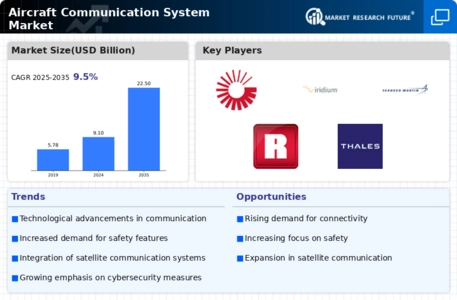Market Share
Aircraft Communication System Market Share Analysis
The Aircraft Communication System market is a pivotal segment within the aviation industry, providing essential communication capabilities for safe and efficient air travel. In this competitive landscape, companies deploy various strategies to position themselves effectively and capture market share. One primary strategy is technological innovation. With the evolution of aviation technology and the increasing demand for reliable communication systems, companies invest in advanced aircraft communication technologies. These innovations encompass a wide range of solutions, including VHF (Very High Frequency), HF (High Frequency), and satellite communication systems, equipped with state-of-the-art features such as digital voice transmission, data link connectivity, and secure communication protocols. By offering cutting-edge solutions that enhance connectivity, improve communication clarity, and ensure interoperability, companies can differentiate themselves and gain a competitive edge in the market.
Branding and reputation management are also crucial aspects of market share positioning in the Aircraft Communication System market. Establishing a strong brand identity and reputation for reliability, performance, and customer support is essential for attracting customers and securing contracts. Companies that provide comprehensive communication solutions, including robust hardware, responsive maintenance services, and reliable technical support, demonstrate their commitment to meeting the unique needs of aviation stakeholders. Positive feedback from airlines, regulatory agencies, and industry associations further strengthens the company's brand image and competitive position in the market.
Price positioning is another critical consideration for companies in the Aircraft Communication System market. While aviation budgets are often constrained, companies must offer competitive pricing and cost-effective solutions to meet the needs of their customers. By optimizing production processes, sourcing components efficiently, and leveraging economies of scale, companies can lower manufacturing costs and offer affordable communication system solutions without compromising quality or performance. Moreover, flexible pricing models, including leasing options and bundled service packages, cater to different customer segments and enhance market penetration.
Distribution and channel management play a significant role in market share positioning in the Aircraft Communication System market. Companies leverage various distribution channels, including direct sales, partnerships with aircraft OEMs (Original Equipment Manufacturers), and collaborations with MRO (Maintenance, Repair, and Overhaul) facilities, to reach customers effectively. Establishing strategic alliances with aviation suppliers, distributors, and regulatory authorities ensures a broad market reach and facilitates access to new customers and markets. Moreover, investing in marketing initiatives, participation in aviation exhibitions and trade shows, and engagement with industry associations enhance visibility, fosters brand recognition, and strengthens customer relationships, thereby reinforcing market position and loyalty.
Strategic partnerships and collaborations are instrumental in gaining market share in the Aircraft Communication System market. Companies often collaborate with aircraft manufacturers, satellite operators, and technology providers to develop integrated communication solutions and value-added services. Joint ventures and consortiums enable companies to pool resources, share risks, and pursue large-scale projects more efficiently. Moreover, partnerships with research institutions, universities, and government agencies facilitate access to funding, regulatory support, and expertise, further enhancing market competitiveness and growth potential.









Leave a Comment